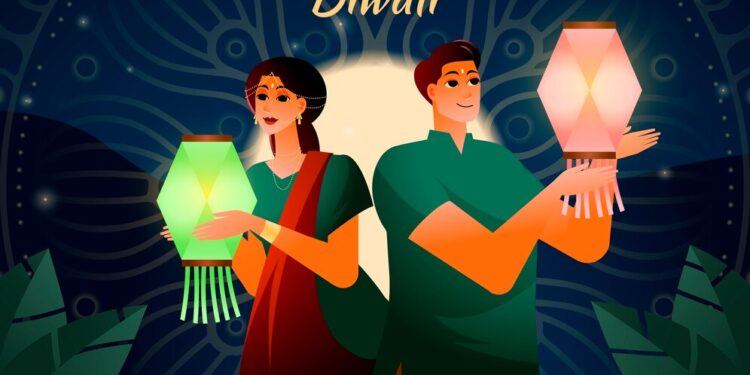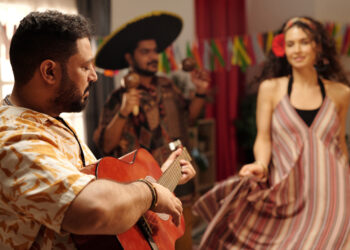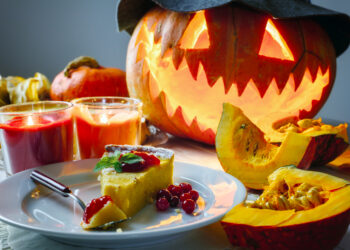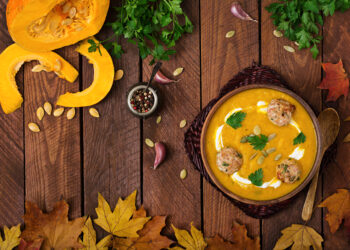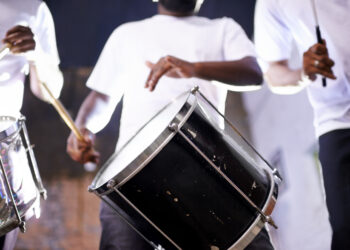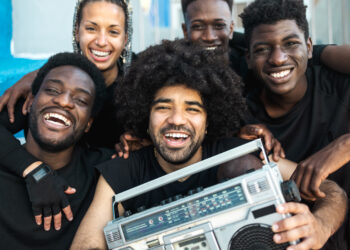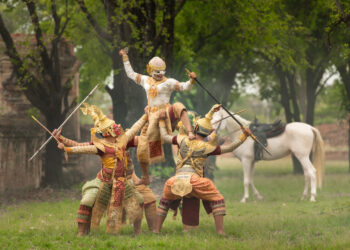Enlightening Expanse: Diwali’s Global Luminescence
Diwali, also known as the Festival of Lights, is one of the most significant festivals in Hinduism and holds immense cultural importance in India. Derived from the Sanskrit word “Deepavali,” Diwali symbolizes the triumph of light over darkness and good over evil.
Celebrated with great zeal and enthusiasm, this festival marks a time of joy, prosperity, and togetherness for Hindus across the globe. With its origins deeply rooted in ancient mythology and religious scriptures, Diwali has evolved into a celebration that transcends borders, spreading its radiant splendour to various corners of the world.
Brief overview of Diwali as the Festival of Lights
Diwali is a five-day-long festival that usually falls between mid-October and mid-November, based on the Hindu lunar calendar. Each day holds its own significance and rituals, but collectively, they depict different aspects of this grand celebration. The festival commences with Dhanteras, a day dedicated to wealth worshipping where people buy gold or silver items as an auspicious start to Diwali festivities.
The following day is celebrated as Choti Diwali or Naraka Chaturdashi – it signifies Lord Krishna’s victory over an evil demon named Narakasura. The third day is when Diwali reaches its peak; it involves lighting earthen lamps (diyas) throughout homes and streets to welcome Goddess Lakshmi, the deity of wealth and prosperity.
Mention of its significance in Hinduism and Indian culture
In Hinduism, Diwali holds immense religious significance as it celebrates different mythological events associated with various deities. Apart from Goddess Lakshmi’s arrival being celebrated on this occasion for wealth blessings, some associate Diwali with Lord Rama’s homecoming to Ayodhya after defeating the demon king Ravana.
This event signifies the victory of good over evil and underlines the importance of righteousness. Additionally, Diwali also marks the beginning of a new Hindu calendar year, emphasizing the significance of renewal and fresh beginnings.
Diwali has transcended borders and is now celebrated with great enthusiasm around the world
Over time, Diwali has surpassed its religious boundaries and expanded its reach beyond India’s borders. With a vibrant Indian diaspora settled in various countries across the globe, this festival has found new homes where it is cherished with equal fervour and joy.
The global celebration of Diwali showcases its universal appeal, serving as a testament to its ability to unite people from diverse cultures under one luminous umbrella of celebration.

Diwali in India: The Epicenter of Celebrations
Deep dive into how Diwali is celebrated in different regions of India
India, being the birthplace of Diwali, is where the festival is celebrated with unmatched fervour and grandeur. Each region of India adds its own unique flavour to the celebrations, making it an incredibly diverse and vibrant affair.
In North India, particularly in states like Uttar Pradesh and Punjab, Diwali marks the return of Lord Rama after defeating Ravana. Elaborate processions and reenactments of this epic tale take place through the streets as people joyously welcome Lord Rama’s victory.
Similarly, in South India, Diwali holds religious significance as it commemorates Lord Krishna’s defeat of a demon named Narakasura. The celebrations include lighting lamps and bursting firecrackers.
Rituals and customs followed during the festival
Diwali is a time for deep spiritual reflection and devotion across all regions of India. People thoroughly clean their homes to welcome Goddess Lakshmi—the goddess of wealth and prosperity—into their abodes.
It is believed that she bestows blessings on those who keep their surroundings tidy and beautiful during this auspicious time. Alongside cleanliness, families perform special prayer rituals known as “Lakshmi Puja” to express gratitude for prosperity and seek blessings for future abundance.
Traditional decorations, such as rangoli and diyas (earthen lamps)
An essential part of Diwali preparations involves adorning homes with vibrant decorations that add a touch of elegance to every corner. Intricate rangoli patterns made from coloured powders or flower petals are meticulously crafted on doorsteps to welcome guests with beauty and grace.
These designs often depict symbols like lotus flowers or geometric patterns, signifying prosperity and good fortune.
Furthermore, earthen lamps called diyas are lit to symbolize the victory of light over darkness and knowledge over ignorance. Rows of lit diyas placed outside homes and temples create a mesmerizing sight, bringing warmth and radiance to the festive atmosphere.
Mouth-watering delicacies prepared for Diwali, like sweets and snacks
No festival in India is complete without indulging in a delectable array of traditional sweets and savoury snacks. Diwali is renowned for its mouth-watering delicacies that tempt everyone’s taste buds.
One such popular sweet is “Gulab Jamun,” deep-fried milk dumplings soaked in sugar syrup, which are enjoyed alongside other sweets like “Barfi” (fudge) made with nuts or coconut.
Additionally, households prepare an assortment of crispy snacks like “Murukku” (rice flour snack), “Chakli” (spiral-shaped snack), and “Namak Pare” (savoury dough strips).
These treats are exchanged with family, friends, and neighbours as a gesture of love, affection, and celebration during Diwali.
By delving into how Diwali is celebrated in different regions of India, understanding the rituals observed during the festival, appreciating the traditional decorations used to create an enchanting ambience, and savouring the diverse range of mouth-watering delicacies enjoyed during this time of joyous festivities, we can truly comprehend why Diwali holds such profound importance within Indian culture and serves as the epicentre from which its global celebrations originate.
Diwali in Nepal: Tihar, a Unique Celebration
Exploration of Tihar, Nepal’s Version of Diwali
Tihar, often referred to as Diwali’s sister festival, is a grand celebration in Nepal that holds its own distinct charm. Lasting for five days, Tihar is an occasion filled with joy and reverence as Nepalese people honour different aspects of life.
Each day has its significance and rituals that are deeply rooted in Nepalese culture. The festival showcases the harmonious coexistence of humans, animals, and nature, emphasizing the importance of their interconnectedness.
Similarities and Differences between Tihar and Diwali in India
While Tihar shares some similarities with Diwali, celebrated in India, there are also notable differences that make it a unique celebration. Both festivals revolve around the triumph of light over darkness but have distinct rituals and customs.
In contrast to the fireworks-centric celebrations seen during Diwali in India, Tihar focuses more on the use of oil lamps (diyas) and intricate rangoli patterns made from coloured powders or flower petals. Additionally, while Diwali typically lasts for three days in India, Tihar spans over five consecutive days, where each day holds significance.
Highlighting Special Rituals like Worshipping Animals on Specific Days
One remarkable aspect of Tihar is the special reverence given to animals on specific days during the festival. On the second day, called “Kukur (Dog) Puja,” dogs are adorned with garlands made from marigold flowers and offered food as a way to recognize their loyalty and companionship to humans.
Similarly, cows are venerated on the third day, known as “Gai (Cow) Puja.” They are decorated with vermilion powder on their foreheads and worshipped for their role in agriculture and the provision of milk.
These unique animal-centric rituals add a distinctive touch to Tihar, showcasing the deep respect Nepalese people hold for all living beings. By embracing Tihar, Nepal has carved out its own identity within the global celebration of Diwali.
The rich tapestry of rituals and customs observed during this festival reflects the cultural diversity and spiritual depth of Nepalese society. To truly appreciate Tihar is to witness the harmonious coexistence between humans, animals, and nature that lies at its heart.

Diwali in Southeast Asia: Embracing Diversity
A Melting Pot of Celebrations
When it comes to celebrating Diwali in Southeast Asia, the region becomes a vibrant melting pot of diverse traditions and cultural expressions. Countries like Malaysia, Singapore, and Indonesia embrace Diwali with open arms, creating a unique tapestry of festivities.
While these countries have their own distinct customs and religious practices, it is fascinating to witness how they have incorporated the essence of Diwali into their local celebrations.
An Overview of Southeast Asian Celebrations
In Malaysia, Diwali is known as “Hari Deepavali” and is celebrated by the large Indian community alongside other ethnic groups. The festival takes on a grand scale, with sparkling lights adorning homes and streets.
Families gather for special prayers at temples and exchange sweets with loved ones. The iconic Kolam decorations embellish entrances, symbolizing prosperity and good fortune.
Similarly, Singapore revels in Diwali vibrancy through its multicultural fabric. Known as “Deepavali” here, the festival showcases not only Indian traditions but also influences from Chinese, Malay, and other communities.
Little India transforms into a kaleidoscope of colours where visitors can indulge in mouth-watering Indian delicacies while witnessing stunning light displays along Serangoon Road.
In Indonesia too, Diwali holds significance for the Hindu community, which commemorates this auspicious occasion with reverence.
Known as “Hari Raya Galungan,” special rituals are performed at temples to honour ancestors and deities. Devotees adorn themselves in traditional attire while intricately crafted “penjor” (bamboo poles) line the streets during this festive period.
Influence of Indian Diaspora on Local Traditions
The Indian diaspora across Southeast Asia has played an instrumental role in shaping local traditions surrounding Diwali. With their rich cultural heritage, they have infused their customs into the fabric of these societies, creating a beautiful blend of Indian and local practices.
Through generations of settlement and intermingling, the Indian diaspora has managed to keep its traditions alive while embracing the host country’s culture. This amalgamation has given rise to unique celebrations that reflect the harmonious coexistence of different ethnic groups within Southeast Asia.
Fusion of Local Customs with Indian Rituals
One remarkable aspect of Diwali celebrations in Southeast Asia is the fusion of local customs with traditional Indian rituals.
From incorporating local flowers into garlands used for prayers to adapting regional music and dance forms into cultural performances, these countries have successfully created a distinctive charm that resonates with both locals and visitors alike.
This blending of customs enhances the multicultural tapestry surrounding Diwali in Southeast Asia, showcasing how traditions can evolve while maintaining their core significance.
It highlights the ability to embrace diversity and find common ground among different cultures during festive occasions. Celebrating Diwali in Southeast Asia is an enchanting experience that showcases the region’s multiculturalism and its embrace of diversity.
Countries like Malaysia, Singapore, and Indonesia offer a unique blend of traditions where the Indian diaspora has played an integral role in shaping local celebrations. The fusion between local customs and time-honoured Indian rituals creates a vibrant tapestry that exemplifies unity amidst diversity during this joyous Festival of Lights.
Diwali in Fiji: An Island Celebration
Exploration of how Fijians celebrate Diwali
When it comes to celebrating Diwali in Fiji, the Indian diaspora has beautifully preserved and integrated their cultural traditions with the local Fijian customs. The festivities commence with vibrant preparations that involve cleaning and decorating homes with colourful rangoli patterns adorning doorsteps.
Fijians, irrespective of their religious background, partake in this celebration, making it a truly multicultural event.
The entire community comes together to illuminate the streets and neighbourhoods with an array of diyas (earthen lamps) that symbolize the triumph of light over darkness. Friends, families, and neighbours exchange sweets and homemade delicacies as a gesture of goodwill and unity.
The history behind Indians settling in Fiji
To comprehend the significance of Diwali celebrations in Fiji, it is crucial to delve into the historical context of Indian settlement on the island. During British colonial rule in India, indentured labourers were brought from various regions to work on sugar plantations in Fiji.
These labourers primarily hail from the Uttar Pradesh and Bihar regions of India and arrived between 1879 and 1916. Over time, they established strong roots in Fiji’s multicultural society by preserving their cultural practices while also adapting to the local lifestyle.
Unique cultural elements incorporated into their celebrations
Diwali celebrations within the Fijian-Indian community encompass unique cultural elements that reflect both their Indian heritage and fusion with Fijian traditions. The festival provides an opportunity for members of different religious backgrounds—Hindus, Muslims, and Sikhs—to come together harmoniously as they celebrate unity amidst diversity.
In addition to traditional rituals such as Lakshmi puja (worship of Goddess Lakshmi) performed at home temples or local mandirs (Hindu temples), Fijians also engage in activities specific to their island culture.
These include showcasing performances of traditional dances like the ‘Fijian Meke’ and organizing grand community gatherings where the sounds of Bollywood music and Fijian beats reverberate in unison. The fusion of Indian attire such as sarees, kurtas, and dhotis with Fijian garments like the sulu (sarong) further exemplifies this unique blending of cultures.
Diwali in Fiji stands as a testament to the power of cultural integration and diversity. It showcases how a festival originating in India has evolved into an inclusive celebration that fosters unity among the different communities residing on this enchanting island while keeping alive their ancestral traditions.
Diwali Surprises in the West: A Global Phenomenon
Exploration of How Diwali Has Spread to Western Countries
Over the years, Diwali has successfully transcended geographical boundaries and become a celebrated event in various Western countries.
The Indian diaspora, along with the growing interest in diverse cultures, has propelled the popularity of this Festival of Lights outside of its traditional homeland. In countries like the United States, Canada, and the United Kingdom, Diwali has garnered immense attention and appreciation.
Hindus living in these nations have embraced their cultural heritage with open arms and have worked tirelessly to promote Diwali as a significant festival that showcases unity, joy, and religious harmony.
In Western countries, organizations such as temples, community centres, and cultural associations take centre stage in organizing grand Diwali celebrations that appeal to both Indians and non-Indians alike.
These events serve as a platform for people from various backgrounds to come together and experience the vibrancy of Indian traditions firsthand.
From dazzling fireworks displays to mesmerizing dance performances showcasing classical Indian forms like Bharatanatyam or Kathak, these multicultural celebrations have become an integral part of many cities’ annual calendars.
Furthermore, local governments have also recognized the significance of Diwali by officially proclaiming it as a public holiday or observing it through cultural festivities. This recognition not only validates the importance of diversity but also fosters inclusivity within society.
Several iconic landmarks around the world also join in by lighting up their facades with colourful displays during Diwali nights – a symbolic gesture that represents global solidarity.
With each passing year, the popularity of Diwali continues to grow exponentially among people from different ethnic backgrounds who are captivated by its message of hope, triumph over darkness (both literal and metaphorical), and celebration of life’s blessings.
Conclusion
Diwali, the Festival of Lights, has truly become a global phenomenon. From its roots in India to its vibrant celebrations in Southeast Asia, Nepal, Fiji, and even the Western world, Diwali has connected people across cultures and brought them together in joyous unity.
Through this festival, we witness the power of cultural exchange and understanding as diverse communities join hands to commemorate the triumph of good over evil.
As Diwali continues to spread its radiance globally, it reminds us all that regardless of our background or beliefs, there is beauty in embracing diversity and celebrating shared values.
The universal message of love, light, and gratitude that Diwali embodies has the potential to inspire individuals worldwide to foster harmony within their communities.
So let us take a moment during this festive season to appreciate the richness of Diwali’s traditions and reflect on their profound impact across continents. May the spirit of Diwali illuminate our lives with compassion and bring us closer as a global family.


